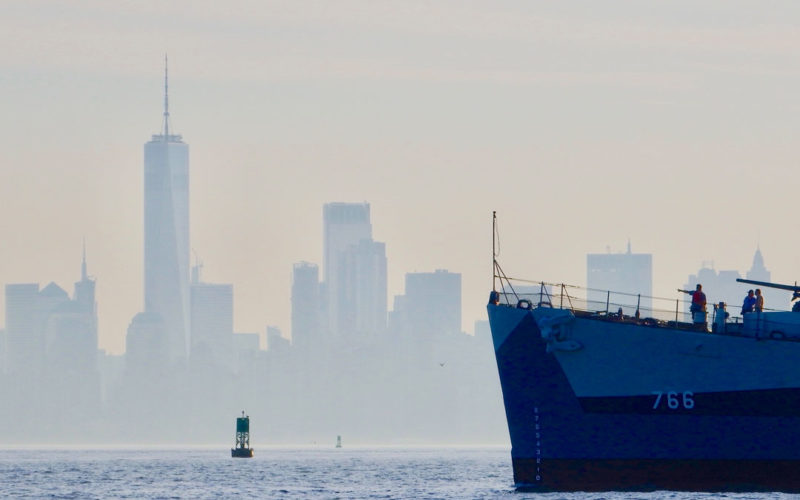Stone scows don’t draw much attention, and the principal activity of the New York State (NYS) Marine Highway Transportation Co. is moving stone. The operator’s tugboats travel up and down the Hudson River with regularity, pushing one or more stone scows, loaded or light, between the quarries and crushers upriver and the countless building projects in metropolitan New York City.
But on July 5, Sarah D. and Nathan G. attracted multitudes on a southbound trip. It called to mind the “crowds of water-gazers” mentioned in the first few paragraphs of Moby Dick. Granted, it was a sunny, spectacular Sunday, and hundreds of miles of riverbank allowed COVID-weary folks to congregate along the waterway and on diverse boats while still respecting social distancing guidelines.
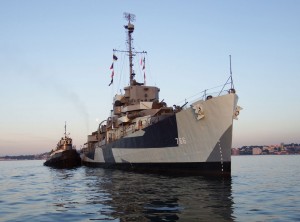
What attracted the crowds was the tow: USS Slater, a World War II-era destroyer escort launched in 1944. In the last months of the war, it accompanied five convoys across the North Atlantic, armed with a variety of U-boat destruction tools — now inert but appearing ready for use on the ship.
A museum attraction vessel in Albany since 1997, the 306-foot Slater has a functional generator, but its main engines — though cosmetically restored — do not run. Therefore, tugboats are essential for it to move.
From 1951 until 1991, Slater sailed for the Greek navy as Aetos (Eagle). In lieu of scrapping it as planned in 1991, the Greeks donated the vessel to the Destroyer Escort Sailors Association, which spearheaded fundraising to have it towed from Crete to New York in 1993. Gephard, a 262-foot Russian tug, was contracted for the trans-Atlantic tow. After passing Gibraltar on a towline, the expectation was that Slater had only a 50 percent chance to survive the crossing.
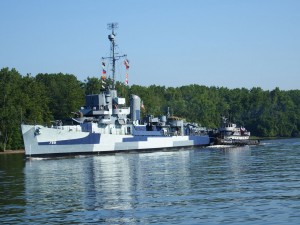
Nearly three decades later, the vessel was headed for a shipyard overhaul that would include hull maintenance, zebra mussel removal, and wiring and restoration work on its 90-foot mast. The project was scheduled at Caddell Dry Dock and Repair, a little over 130 nautical miles downriver from Albany in Staten Island.
Since December, Slater volunteers had worked countless hours to prepare for this shipyard run, partially funded by grants. Addressing the 42-item to-do list coalesced the group through the winter, with the transit downriver scheduled for March. COVID-19 changed everything, and the shipyard visit was postponed until October. In early June, however, Caddell contacted the Slater team about an unexpected immediate opening at one of its dry docks. NYS Marine Highway, whose base in Troy is only a few miles from the Slater dock, could have tugboats ready for the tow in 48 hours. The timing worked out perfectly: Sarah D. would deliver empty stone scows upriver, and then Slater would be its backhaul.
Right down to the last scorching afternoon, volunteers rallied to complete every item on their checklist, adding a refrigerator, gas grill and supplies for the 15-person crew that would live on the vessel in the shipyard. One of the volunteers aboard, a former restaurateur, was designated as cook. Breakfast would come out of the galley, and all else from the grill.
Sarah D. arrived at dawn on July 5. As the crew readied the lines, Capt. John Herman verified the best towing points. An hour later, the tug was made up to the starboard stern of Slater. Nathan G. arrived and delivered the Upper Hudson pilot Paul Chevalier, who would stay aboard until he handed off to a Lower Hudson pilot about 50 nautical miles downriver. Canvas had been attached to the fendering on the tugs to protect the World War II dazzle paint on Slater’s hull.
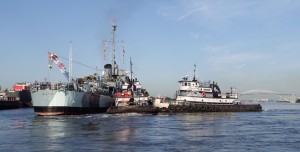
Once a mobile crane on the dock removed the gangway connecting Slater to the museum space, NYS Marine Highway crew coordinated the line drop. The tugs rotated the warship toward the Rensselaer side of the Hudson, then pointed it south. The tow soon moved past the Port of Albany for the start of a roughly 24-hour voyage. Several miles downriver, Nathan G. made fast on Slater’s stern port quarter.
“A side tow arrangement allows greater control. Vessels like Slater are not designed to be towed; the ship would sway one direction and then the other,” said Chris Deeley, operations manager at NYS Marine Highway. For the tow from Crete to New York in 1993, special towing points had to be welded to the ship.
Sarah D., with greater horsepower, size and draft than Nathan G., powered the tow from starboard and followed the right-hand side of the channel. Nathan G. aided, providing Sarah D.’s captain with visibility along the port side. Although its engines were running and in gear, Nathan G.’s rudder stayed fixed so that it would not interfere with Sarah D.’s steering. If needed in turns, Nathan G. could assist.
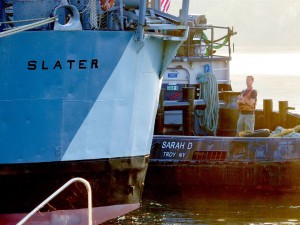
The number of boats on the river — either there to greet the “spectacular warship,” as a Poughkeepsie radio station called it, or out for other types of recreation — increased the potential for problems. Recreational boaters don’t always understand the risks in navigating near a commercial tow. To keep overexuberant boaters from getting too close, a spontaneous escort of public safety patrol boats joined the tow.
“It was unplanned but really helpful,” said Herman, a Massachusetts Maritime Academy graduate who has been with NYS Marine Highway full time since 2016. “It enhanced our margin of safety. More than a dozen, maybe two dozen different jurisdictions rotated in and out along the way. When they needed to break off and return to their area upriver, they’d call in and announce that, wishing us well.”
Some towns stationed fire trucks along the river, their ladders and towers festooned with flags. “I felt very proud,” Herman said. “Rounding the bend at West Point especially, with all the crowds, was amazing. Even after dark, people flashed their car headlights, messages in Morse code maybe. I’ve never seen anything like it.”
In the wee hours under a full moon, a Sandy Hook pilot replaced the Lower Hudson pilot at Yonkers and coordinated with vessel traffic service as the tow closed in on its 0730 appointment at Caddell.
By 0500, the tow had passed the Statue of Liberty. As the moon descended over Staten Island and the sun rose over Brooklyn, the water was smooth and the air was quiet, a stark contrast to the crowds of the previous day.
The 0730 arrival at Caddell coincided with the height of flood tide current there, but the docking was perfect. “We do this all the time,” Herman said. Along the river Slater was unique, but when it came to docking, the technique was the same as for a stone scow.

